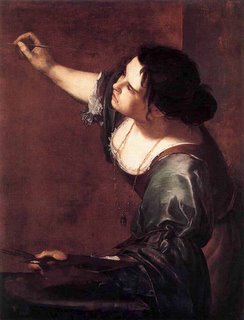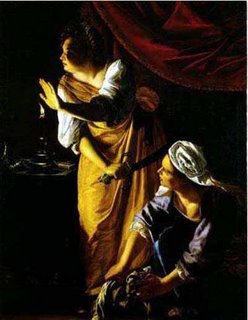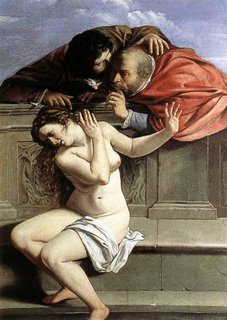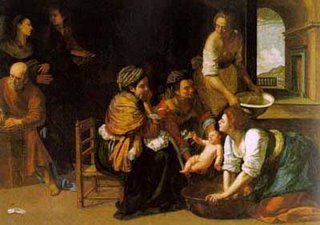Art..emisia
One of my favorite classes this semester is Art History 102. It covers the early Renaissance up through the early 1900s. We get to study all the big, important guys like Donatello, DaVinci, Michelanglo, Raphael (and other assorted teenage mutant ninja turtles) as well as some pretty cool architechts like Alberti and Bramonte. One of the things sadly lacking, as I expected, is any discussion of female artists. Not a big surprise, really. During the period we're concentrating on women couldn't go outside without an escort, they couldn't own property in most places and were routinely sold into marriage for a few acres of good grazing land. They certainly could not attend any schools, much less look at the male nude form in order to study classical technique. I always found it interesting that there are hardly any female painters in the Metropolitan Museum of Art, but there sure are a lot of pictures of nude women on the walls. Typical. So I was thrilled that we got to briefly discuss the work of Atemisia Gentileschi in class last week. Because of the restrictions placed on women, what female artists there were at the time mostly painted portraits and landscapes. They certainly weren't getting any of the big commissions from mama church or the local aristocracy. Artemisia was an incredibly talented painter who was the first female artist to paint major religious and historical scenarios.
So I was thrilled that we got to briefly discuss the work of Atemisia Gentileschi in class last week. Because of the restrictions placed on women, what female artists there were at the time mostly painted portraits and landscapes. They certainly weren't getting any of the big commissions from mama church or the local aristocracy. Artemisia was an incredibly talented painter who was the first female artist to paint major religious and historical scenarios.
Sadly, but not unexpectedly, her life was not without troubles. Her father, a successful artist, recognized her precocious genius and sent her to study with an artist named Agosino Tassi. Tassi took advantage of the situation and raped her. There was a long, highly publicized trial that lasted for seven months around the time Artemisia was 18 or so. She was subjected to vaginal examination, torture with thumbscrews and accused publicly of being unchaste. Tassi was eventually sentenced to banishment from Rome, but due to his powerful relationships within the local government, he was back in town within four months.
Some people believe that Artemisia used her art to cathartically and symbolically work through the pain. Just take a look at these for example.

 The first painting is called Judith and Maidservant With the Head of Holofernes. It's a rendition of the old testament story from the book of Judith. Judith was a beautiful widow who sneaked into the enemy camp of the invading Babylonian army. She seduced the general, Holofernes, then beheaded him while he slept off the night of drinking and debauchery, thus securing the victory and salvation of her people. Tough gal, huh?
The first painting is called Judith and Maidservant With the Head of Holofernes. It's a rendition of the old testament story from the book of Judith. Judith was a beautiful widow who sneaked into the enemy camp of the invading Babylonian army. She seduced the general, Holofernes, then beheaded him while he slept off the night of drinking and debauchery, thus securing the victory and salvation of her people. Tough gal, huh?  This is Susanna and the Elders. This painting is a scene from the Old Testament story of Susanna. She was a respectable Jewish married lady. In this painting the corrupt town elders have hidden in her garden while she is having a bath. They tell her that she has to "lay" with them or else they will tell everyone that she was waiting for her lover in the garden. She refuses and they put her on trial for adultery. Finally, a young man named David believes Susanna and questions the elders separately. They can't agree on what kind of tree Susanna was sitting under and are convicted of being dirty old lying attempted rapists and are put to death. (Ok, maybe that's not what the story said exactly...)Look at how Artemisia has portrayed Susanna's reaction to the men's advances. It's quite a different telling than this one by Rembrandt.
This is Susanna and the Elders. This painting is a scene from the Old Testament story of Susanna. She was a respectable Jewish married lady. In this painting the corrupt town elders have hidden in her garden while she is having a bath. They tell her that she has to "lay" with them or else they will tell everyone that she was waiting for her lover in the garden. She refuses and they put her on trial for adultery. Finally, a young man named David believes Susanna and questions the elders separately. They can't agree on what kind of tree Susanna was sitting under and are convicted of being dirty old lying attempted rapists and are put to death. (Ok, maybe that's not what the story said exactly...)Look at how Artemisia has portrayed Susanna's reaction to the men's advances. It's quite a different telling than this one by Rembrandt.
Birth of St. John The Baptist - quite the cozy, domestic scene isn't it? I love how the birth is dominated by (gasp!) women who traditionally controlled birthings. Not sure who the old guy is on the right though.






6 comments:
Those are powerful paintings! Great post, too. I don't remember learning about her in my art history class...
Wow. Thanks so much for sharing that! I had never heard of Artemisia before today. Which is a shame, because I see she was really just incredibly talented. I'm pretty blown away by those paintings.
Oh you are so cool. Why can't any of my art history students be as involved as you?? The omission of female artists from the canon of art history (and many other disciplines) is a serious problem. This has as much to do with the system (the historians and writers, the teachers and the textbook publishers) as with the actual status of women in society. Fortunately, feminist theory has shaken up art history in the last couple of decades, so now there is a plethora of books, articles, etc. that address the issue you raise. Hopefully people will see the beautiful paintings by Gentilleschi that you have put up here and be inspired to go out and explore the topic more!
P.S. When I was an art history TA, it was often 4-5 women TAs and 1 male professor, so we would often gang up on him and make him include more women in the syllabus! Or pick up the slack and introduce artists in our sections that the lecture left out.
Meesh, an excellent learning session for you and for us through you. THANK YOU for this. Wow, the difference in the way the Jewess is portrayed is striking. Frightening is all i could think... Thank you for a thought-provoking post, as always. You gave us all some good food for thought.
This is so interesting! Hard to imagine it all. Thanks for sharing some of your class & knowledge with us. I love visiting museums & art galleries, but don't get to nearly as much as I'd like.
I was really happy to see your blog about Atemisia Gentileschi. I too enjoy her work. I believe that both of the Judith and Holofernes paintings are in the Detroit Institute of Arts. I know for sure that the Judith and Maidservant with the Head of Holofernes is in the DIA.
Post a Comment